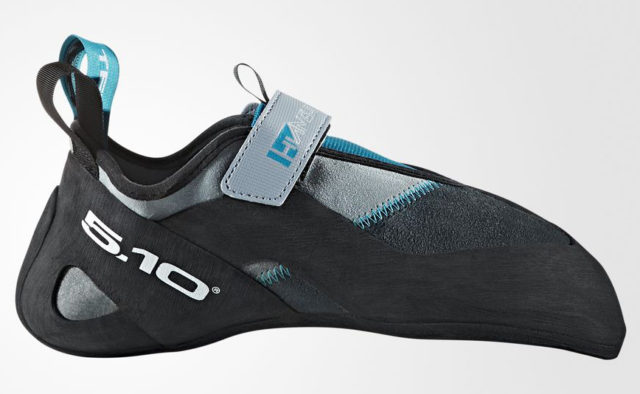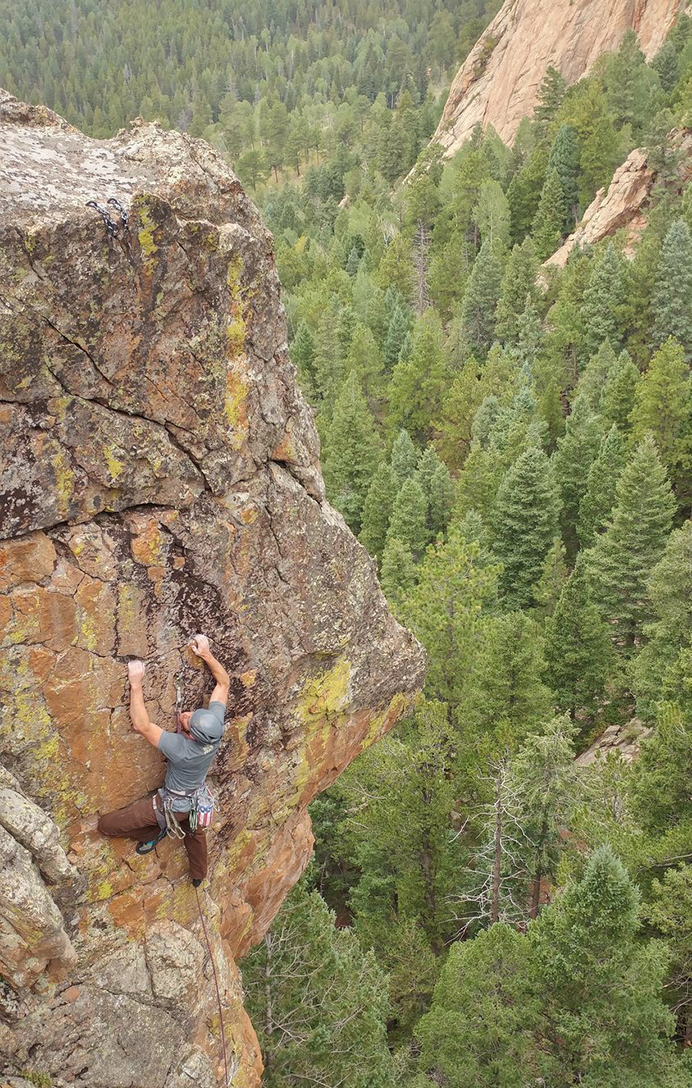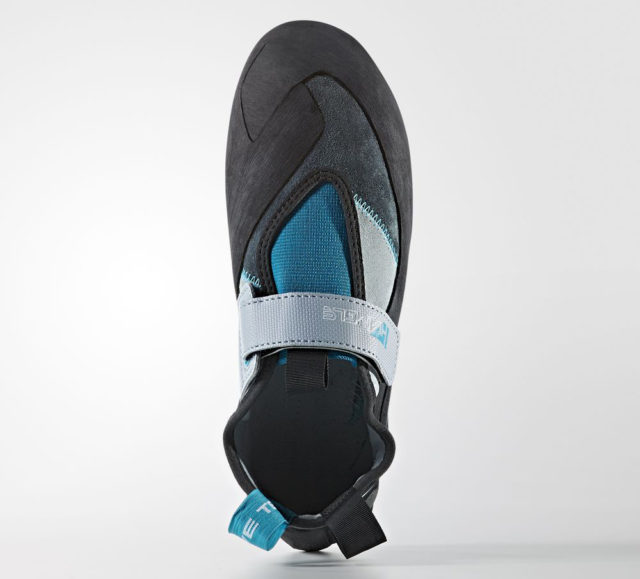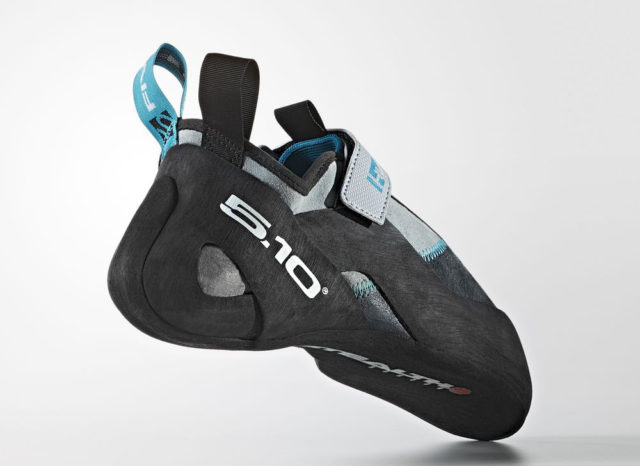
Five Ten Hiangle
Stated Features:
- Stealth® C4™ rubber outsole (4.2mm)
- Unlined leather upper — half-size stretch
- Single-strand Velcro closure system
- Stiffest Aggressive model
MSRP: $165
Size Tested: 13
Days Tested: 40
Test Locations: Clear Creek Canyon, Shelf Road, Boulder Canyon, & South Platte, CO; Ten Sleep & Wild Iris WY; Spearfish Canyon, SD; Red Rock Canyon, NV.
Intro
Five Ten describes the Hiangle as an “all-around performance shoe that is relaxed enough for all day climbing, yet aggressive enough to tackle steep, overhanging routes.” As many climbers have learned, achieving both of these characteristics (relaxed enough + aggressive enough) in one shoe is easier said than done. So this review aims to unpack that claim and provide a clearer idea of what the Hiangle really is; how it compares to some other shoes in this category; and what sort of climbing (or climber) it’s best suited for.
Geometry, Fit, and Comparisons
Five Ten states that the Hiangle is “said by many to be the most comfortable of our downturned climbing shoes,” and indeed, the Hiangle fit me comfortably right out of the box with very little dead space. Obviously, “comfort” and “fit” are quite subjective, but for my medium-volume feet, there aren’t many other aggressive shoes that I’ve tried that manage this snug of a fit without being uncomfortable.
Having said that, the Hiangle is lower volume than other recent additions to Five Ten’s aggressive shoes, such as the Quantum. The fit of the Hiangle is closer to what many have come to expect from most La Sportiva and Scarpa shoes, and is an important consideration when determining if the Hiangle will work for your foot.
As for the “all-day comfort” assertion, it’s true that the Hiangle is an extremely comfortable shoe for being significantly downturned. But I wouldn’t say that the Hiangle fully pulls off double duty as an all-day shoe. The key here is that it is extremely comfortable for an aggressive shoe.

Personally, when I think “relaxed enough for all-day climbing,” I think of shoes like the La Sportiva TC Pro & Mythos, Five Ten Moccassym & Anasazi series, Scarpa Techno X, Butora Altura, etc. Those are all shoes I have worn for more than six pitches without so much as popping out my heels at the belays. By contrast, I exclusively deploy the Hiangle for boulders and single-pitch work. Not that one couldn’t take them off at belay stances as needed and be successful on a longer route (after all, this would be akin to doing a half-dozen single-pitch routes at a crag and taking off the shoes after each one). But I don’t think this is quite the same as saying you’ll be totally fine wearing the Hiangle uninterrupted for 10 hours. They’re comfy, but they’re still aggressive, so you should expect your feet to tire out and get unhappy if you wear them for too long.
Construction & Stiffness
The Hiangle features a 4.2 mm sole, which is thicker than all of Five Ten’s aggressive shoes except the Quantum (which also features the 4.2 mm sole). As a result, Five Ten claims that the Hiangle is their stiffest aggressive shoe.
But while there is definitely some rigidity to the Hiangle’s toe box, I didn’t find it to feel particularly stiff compared to other aggressive shoes. For starters, I found the Quantum to be stiffer than the Hiangle. This difference in flex is even more pronounced when placing the Hiangle in the broader context of all aggressive shoes. The Hiangle may be stiffer than most of Five Ten’s other aggressive shoes (like the Blackwing), but the Hiangle is by no means “stiff” relative to most of its peers (e.g., the Evolv Shaman & Agro, Scarpa Instinct VS, or Sportiva Miura VS & Solution).
That said, I actually really like the flex of the Hiangle. It’s just that I was surprised to hear the shoe described as “stiff,” so be aware if you are making the switch from genuinely stiff shoes like the ones listed above.

Again, this isn’t a knock against the Hiangle (this is very much a personal preference issue), just a note of differentiation. In fact, it is one of the things that I like most about the Hiangle — it’s a medium-stiff shoe whose rigidity comes solely from its shape and rubber, rather than the inclusion of plastics or other materials designed to add rigidity. That is to say, the downturned shape of the Hiangle coaxes your foot into a position where it is less easily bent up and away from holds. Of course, this is the principle on which most aggressive shoes are built, but the Hiangle is atypical in the current climbing shoe market due to the fact that the Hiangle doesn’t try to amplify this rigidity with a stiffening plate (such as Sportiva’s P3 system). Five Ten’s Blackwing is similar to the Hiangle in this regard (as are a select few other shoes) but it’s much more the exception than the rule across the industry. And the upside to all this is that the slightly softer feel allows for a high degree of sensitivity — especially for a modern, aggressive shoe.
Rubber, Closure, Etc.
The closure of the Hiangle consists of a single Velcro strap at the top of the upper. This constricts the opening a little bit, and I initially found the shoe challenging to get on.

However, after a few days of breaking them in, the leather softened up and the shoe was easier to get into. While the Hiangle’s leather upper has some play, the C4 rubber on the sole is laminated all over the toe box and sides of the shoe, which keeps stretching to a minimum. You can expect the shoe to maybe stretch about a half-size or less — I went with my street shoe size and they fit well for the lifetime of the shoe without getting sloppy. As I mentioned above, much of the power of the Hiangle comes from the downturn, so getting the fit dialed is really worth it, and important. If the shoe is uncomfortably tight when you try them on, don’t forge ahead and wait for the break-in — try them a half-size up.
The over-ambitious application of rubber on the Hiangle’s forefoot is not only effective at reducing stretch, it also helps with toe hooking. You get a lot of rubber to work with on the front-inside swath of the upper, making it easier to get the most out of a toe-hooked smear or chip. On the heel, the stripe of rubber on the back of the shoe is pretty narrow, which I have mixed feelings about. It seems designed to stay out of the way in order to let you grab smaller holds with the smooth corner of the heel, rather than slipping on and off the panel of rubber. To this end it works fairly well, but if the point of the thinner rubber strip is to keep it out of the way, why not forego it altogether?

Sensitivity and Performance
Apart from the rubber panel on the heel, all of the factors detailed above combine to make the Hiangle among the best shoes out there for folks who want a legitimately aggressive downturn and an equitable blend of sensitivity and stiffness (at least in the toe box). I came to love the Hiangle for edging and techy face climbing since I got enough precision and sensitivity to hit holds properly without entirely sacrificing the benefits of a downturned shoe.
The Hiangle’s toe box has a relatively rounded snout which isn’t as tapered as some other shoes in this class (e.g., the Scarpa Instinct VS or Boreal Mutant). This makes the Hiangle good-but-not-great for the hard, pocketed limestone found at crags like Wild Iris and Ten Sleep, WY.
Durability
The Hiangle held up as long as I would typically expect before I took them in for a resole. But once at the resoler, I was told I had blown through some of the stitching beneath the toe-cap. Waiting too long to send in your shoes to the resoler and thereby destroying them in the process is an epidemic in the climbing community, but that wasn’t the case here. In this case, the rand rubber was still intact (not yet being worn out) and the damage was to the stitching beneath, which indicates a problem with the construction of the stitching. I’ve never had this problem with another pair of shoes, so I did what you should do if this happens to you: call Five Ten. They said that it’s something that happens from time to time, and to send them in. So I did, and they took a look and replaced them, no questions asked. Good.
Bottom Line
The Five Ten Hiangle is a fantastic, high-performance sport and bouldering shoe, providing an unusual combination of edging power, sensitivity, and comfort. If you‘re looking for powerful edging with little regard for sensitivity, you’ll probably be better off with something stiffer like the Scarpa Instinct VS, Evolv Agro, or Sportiva Miura VS. Additionally, sport climbers whose projects mostly consist of pocketed limestone may find themselves a little underwhelmed by the rounded toe shape of the Hiangle. However, for the majority of boulderers and sport climbers, the Hiangle blends those factors together artfully, rather than going all-in on one of them.
